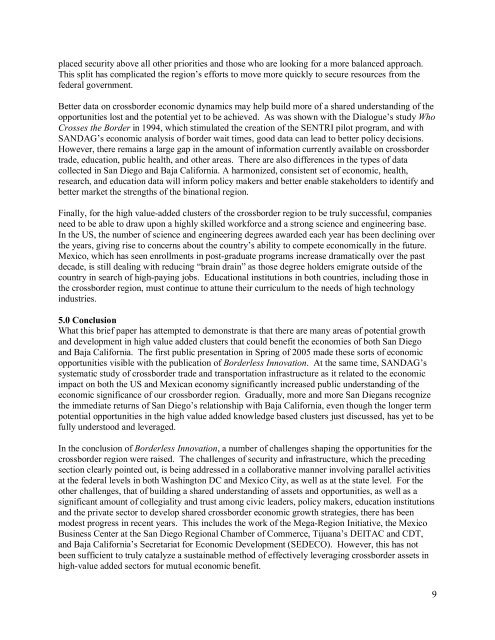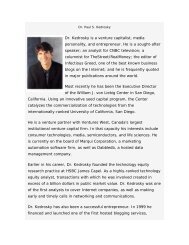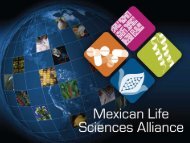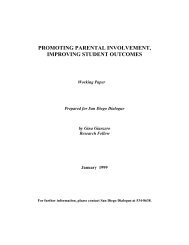Corridors and Clusters - San Diego Dialogue
Corridors and Clusters - San Diego Dialogue
Corridors and Clusters - San Diego Dialogue
Create successful ePaper yourself
Turn your PDF publications into a flip-book with our unique Google optimized e-Paper software.
placed security above all other priorities <strong>and</strong> those who are looking for a more balanced approach.<br />
This split has complicated the region’s efforts to move more quickly to secure resources from the<br />
federal government.<br />
Better data on crossborder economic dynamics may help build more of a shared underst<strong>and</strong>ing of the<br />
opportunities lost <strong>and</strong> the potential yet to be achieved. As was shown with the <strong>Dialogue</strong>’s study Who<br />
Crosses the Border in 1994, which stimulated the creation of the SENTRI pilot program, <strong>and</strong> with<br />
SANDAG’s economic analysis of border wait times, good data can lead to better policy decisions.<br />
However, there remains a large gap in the amount of information currently available on crossborder<br />
trade, education, public health, <strong>and</strong> other areas. There are also differences in the types of data<br />
collected in <strong>San</strong> <strong>Diego</strong> <strong>and</strong> Baja California. A harmonized, consistent set of economic, health,<br />
research, <strong>and</strong> education data will inform policy makers <strong>and</strong> better enable stakeholders to identify <strong>and</strong><br />
better market the strengths of the binational region.<br />
Finally, for the high valueadded clusters of the crossborder region to be truly successful, companies<br />
need to be able to draw upon a highly skilled workforce <strong>and</strong> a strong science <strong>and</strong> engineering base.<br />
In the US, the number of science <strong>and</strong> engineering degrees awarded each year has been declining over<br />
the years, giving rise to concerns about the country’s ability to compete economically in the future.<br />
Mexico, which has seen enrollments in postgraduate programs increase dramatically over the past<br />
decade, is still dealing with reducing “brain drain” as those degree holders emigrate outside of the<br />
country in search of highpaying jobs. Educational institutions in both countries, including those in<br />
the crossborder region, must continue to attune their curriculum to the needs of high technology<br />
industries.<br />
5.0 Conclusion<br />
What this brief paper has attempted to demonstrate is that there are many areas of potential growth<br />
<strong>and</strong> development in high value added clusters that could benefit the economies of both <strong>San</strong> <strong>Diego</strong><br />
<strong>and</strong> Baja California. The first public presentation in Spring of 2005 made these sorts of economic<br />
opportunities visible with the publication of Borderless Innovation. At the same time, SANDAG’s<br />
systematic study of crossborder trade <strong>and</strong> transportation infrastructure as it related to the economic<br />
impact on both the US <strong>and</strong> Mexican economy significantly increased public underst<strong>and</strong>ing of the<br />
economic significance of our crossborder region. Gradually, more <strong>and</strong> more <strong>San</strong> Diegans recognize<br />
the immediate returns of <strong>San</strong> <strong>Diego</strong>’s relationship with Baja California, even though the longer term<br />
potential opportunities in the high value added knowledge based clusters just discussed, has yet to be<br />
fully understood <strong>and</strong> leveraged.<br />
In the conclusion of Borderless Innovation, a number of challenges shaping the opportunities for the<br />
crossborder region were raised. The challenges of security <strong>and</strong> infrastructure, which the preceding<br />
section clearly pointed out, is being addressed in a collaborative manner involving parallel activities<br />
at the federal levels in both Washington DC <strong>and</strong> Mexico City, as well as at the state level. For the<br />
other challenges, that of building a shared underst<strong>and</strong>ing of assets <strong>and</strong> opportunities, as well as a<br />
significant amount of collegiality <strong>and</strong> trust among civic leaders, policy makers, education institutions<br />
<strong>and</strong> the private sector to develop shared crossborder economic growth strategies, there has been<br />
modest progress in recent years. This includes the work of the MegaRegion Initiative, the Mexico<br />
Business Center at the <strong>San</strong> <strong>Diego</strong> Regional Chamber of Commerce, Tijuana’s DEITAC <strong>and</strong> CDT,<br />
<strong>and</strong> Baja California’s Secretariat for Economic Development (SEDECO). However, this has not<br />
been sufficient to truly catalyze a sustainable method of effectively leveraging crossborder assets in<br />
highvalue added sectors for mutual economic benefit.<br />
9






